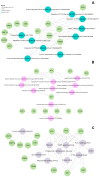Assessing Creatine-Related Gene Expression in Kidney Disease: Can Available Data Give Insights into an Old Discussion?
- PMID: 40004980
- PMCID: PMC11858045
- DOI: 10.3390/nu17040651
Assessing Creatine-Related Gene Expression in Kidney Disease: Can Available Data Give Insights into an Old Discussion?
Abstract
The impact of creatine supplementation on individuals with kidney disease or pathological conditions with an increased risk of developing kidney dysfunction remains an active discussion. However, the literature on gene expression related to cellular creatine uptake and metabolism under altered renal function is scarce. Therefore, the present study utilized comprehensive bioinformatics analysis to evaluate the expression of creatine-related genes and to establish their relationships to normal and disturbed renal conditions. We identified 44 genes modulated explicitly in response to creatine exposure from a gene enrichment analysis, including IGF1, SLC2A4, and various creatine kinase genes. The analysis revealed associations with metabolic processes such as amino acid metabolism, indicating a connection between creatine and tissue physiology. Using the Genotype-Tissue Expression Portal, we evaluated their basal tissue-specific expression patterns in kidney and pancreas tissues. Then, we selected several pieces of Gene Expression Omnibus (GEO) transcriptomic data, estimated their expression values, and established relationships to the creatine metabolism pathways and regulation, shedding light on the potential regulatory roles of creatine in cellular processes during kidney diseases. These observations also highlight the connection between creatine and tissue physiology, emphasizing the importance of understanding the balance between endogenous creatine synthesis and creatine uptake, particularly the roles of genes such as GATM, GAMT, SLC6A8, and IGF1, under several kidney dysfunction conditions. Overall, the available data in the biological databases can provide new insights and directions into creatine's effects and role in renal function.
Keywords: creatine monohydrate; kidney; renal injury; review.
Conflict of interest statement
The authors declare no conflicts of interest.
Figures









References
-
- Antonio J., Candow D.G., Forbes S.C., Gualano B., Jagim A.R., Kreider R.B., Rawson E.S., Smith-Ryan A.E., VanDusseldorp T.A., Willoughby D.S., et al. Common questions and misconceptions about creatine supplementation: What does the scientific evidence really show? J. Int. Soc. Sports Nutr. 2021;18:13. doi: 10.1186/s12970-021-00412-w. - DOI - PMC - PubMed
Publication types
MeSH terms
Substances
LinkOut - more resources
Full Text Sources
Medical
Miscellaneous

